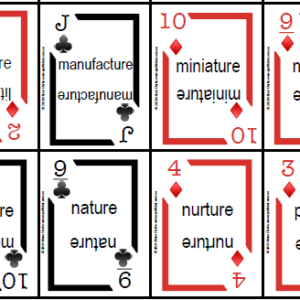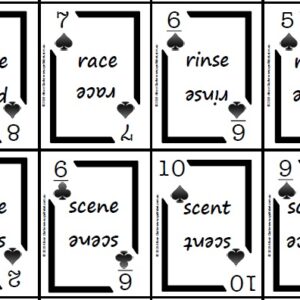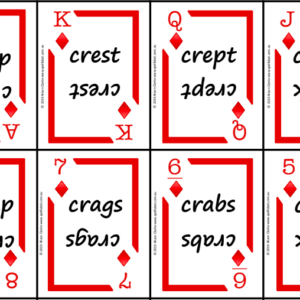12 extra decks of phonics playing cards
$AUD13.33
Download and print 12 decks of our child-sized (5 X 6.5cm) playing cards for fun reading practice. These decks fill some gaps in our previous decks – compound words, “soft” C and G, additional spellings of “short” vowel sounds – and then present additional consonant sounds with multiple spellings. Words face both up and down, for easy reading from either side of a table.
Description
Download and print 12 decks of our child-sized (5 X 6.5cm) extended code playing cards, for fun reading practice involving plenty of repetition-to-mastery. Words are printed facing both directions, so they are easily read from either side of a table.
These decks focus on the following:
- Compound words with “short” vowels like “backpack”, “chestnut”, “drumstick”, “eggshell”, “grandstand”, “himself”, “lipstick”, “mothball”, “quicksand”, “stronghold” and “uphill”.
- The letter C pronounced /s/, as in “cement”, “ice”, “place”, “pencil”, “produce”, “civil”, “race” and “recent”.
- The letter G pronounced /j/, as in “age”, “danger”, “giant”, “huge”, “refugee”, “surgical”, “tragic” and “vigil”.
- The sound /e/ spelt E as in “bed”, EA as in “bread”, AI as in “again”, A as in “any”, U as in “bury”, EI as in “leisure”, IE as in “friend”, and EO as in “leopard”.
- The sound /i/ spelt I as in “did”, Y as in “myth”, E as in “English”, U as in “busy”, O as in “women” and IE as in “sieve”.
- The “short” sound /oo/ spelt OO as in “cook”, U as in “full”, OUL as in “would” and O as in “woman”.
- The sound /m/ spelt MM as in “common”, MB as in “climb”, MN as in “solemn”, ME as in “come” and GM as in “phlegm”.
- The sound /n/ spelt NN as in “tunnel”, KN as in “know”, GN as in “gnome”, NE as in “caffeine”, NNE as in “julienne”, PN as in “pneumatic” and MN as in “mnemonic”.
- The sound /t/ spelt TT as in “tattoo”, TE as in “torte”, TTE as in “statuette”, BT as in “subtle”, TH as in “Thailand”, PT as in “receipt” and CHT as in “yacht”.
- The sound /k/ spelt CC as in “broccoli”, CH as in “scheme”, QU as in “quiche”, QUE as in “opaque”, CQU as in “acquit”, CCH as in “zucchini” and KH as in “khaki”.
- The sound /g/ spelt GG as in “juggle”, GU as in “guy”, GH as in “ghetto”, GUE as in “synagogue”, and GE as in “renege”.
- The sound /r/ spelt RR as in “mirror”, WR as in in “wrong”, RH as in “rhubarb” and RRH as in “diarrhoea”.
These card decks can be used as part of most phonics/morphology-based reading/spelling teaching sequences. They can be sent home instead of a spelling list, with the expectation that students will learn to both read and spell the words accurately, and with a random sample of the words on an upcoming spelling quiz.
We suggest printing the cards on A4 200gsm cardboard, and if you plan to use them a lot, laminate them. We highly recommend that children practise their scissor skills by cutting them up, rounding the corners if a more professional look is sought.
The cards can be used to play any card game requiring a typical deck of playing cards, but players must read the cards’ words as they play them. We’ve made some videos of example games to get you started:
- California Speed
- Spit
- Snip Snap Snorum
- War
- Beggar Thy Neighbour
- Slapjack
- Snap
- Mancala, for which you’ll also need to download our Mancala board.
If you’re looking for more/different games, do an internet search for “kids’ playing card games”, and you’ll find plenty, including lots of videos showing how to play. Enjoy!
Related products
 The Spelfabet shop has affordable, downloadable spelling teaching resources.
The Spelfabet shop has affordable, downloadable spelling teaching resources.







